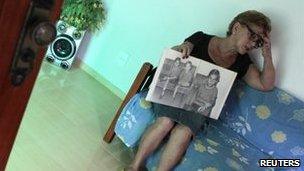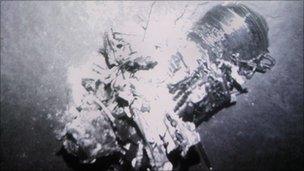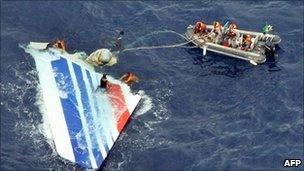Conflicting emotions of Air France crash relatives
- Published

The relatives all have their own feelings on the raising of the wreck
The discovery of Air France flight 447, which crashed over the mid-Atlantic two years ago, is a major breakthrough in the search for the cause of the disaster.
But for families of the 228 people who died, the news also brings anguish and doubt.
Last weekend, along with wreckage of the Airbus 330, the undersea probes found the bodies of many of the victims.
In three weeks, operations will begin to lift the fuselage from its resting-place nearly four kilometres beneath the surface.
An unknown number of bodies will also be retrieved.
'Leave the bodies'
Inevitably, this is reawakening the pain among those who mourn.
"Among the families there are two groups," says Robert Soulas, who lost his 24 year-old daughter Caroline and her husband, Sebastien.
"There are those like me who would prefer to leave the bodies on the ocean floor. And there are those who would like to bring them up for identification and burial. The second group is definitely bigger.

Undersea robots finally uncovered a large part of the wreckage, including bodies, on Sunday
"But in a sense the debate is futile. The French government has made it clear: bodies will be brought to the surface. So there is no choice in the matter," he told the BBC.
No-one has a full picture yet of how many bodies have been discovered.
In the weeks after the crash in June 2009, some 50 bodies were retrieved from the surface.
The probes are believed to have recorded images of dead passengers still in their seats. But Mr Soulas has been told that other bodies were spotted lying around the wreckage.
It is also not clear in what state the human remains are. For obvious reasons no photographs containing bodies have been released.
Le Parisien newspaper has reported that most of them are "skeletal and show numerous fractures and other damage caused by the impact."
However forensic doctor Michel Sapanet said the depth of the water should have helped preserve the remains.
"The great depth means cold temperatures and a very small amount of oxygen in the water. These are good conditions for preservation. Fatty tissue can transform into a kind of hard wax which slows decomposition," he said.
He said that lifting the bodies to the surface will require great care, because of the changes in undersea pressure.
Once they are retrieved, there should be little difficulty identifying the bodies - either by distinguishing marks, or dental records, or DNA. Those in seats can be traced via the check-in log.
Re-assembly of parts
For Mr Soulas, the weeks ahead promise to be traumatic.

Floating debris was found immediately after the crash
"It is going to be very painful," he said.
"It's two years since we lost Caroline and Sebastien, and over that time we have come to terms with what happened.
"Now we are suddenly confronted with a new situation, in which we may have to take charge of the remains, identify them, arrange for the burial and so on."
Among his fears is that the body of one of the couple may be recovered but not the other. "That would be terrible for us, to separate them like that," he said.
The French Accident Investigation Bureau (BEA) must now choose the vessel which will carry out the recovery at the start of May.
The only ships equipped for the task are deep-sea cable-layers used by telecommunications companies, and three are bidding for the job.
The ships deploy remote ocean-floor tracked vehicles equipped with cameras, robotic arms, and cutters. They will dissect the fuselage into manageable sections which can be raised to the surface.
According to Mr Soulas, not all of the aircraft will be recovered - only those parts deemed essential for the investigation.
It is therefore possible that some bodies - those in sections of the plane that are left on the sea-bed - will not be retrieved.
The recovered parts of the airliner will be taken to Airbus headquarters in Toulouse, southern France, for re-assembly with sections found on the surface.
There is much optimism that the two flight-recorders will be retrieved, with their information intact.
The families - who come from more than a dozen nationalities - will find out more at a meeting with the BEA in Paris in two weeks.
- Published4 April 2011
- Published5 April 2011
- Published3 April 2011
- Published17 March 2011